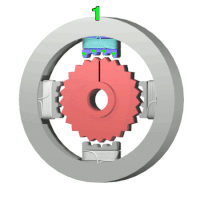
Back Stapmotor Afrikaans محرك خطوي Arabic Addım mühərriki Azerbaijani Крокавы электрарухавік Byelorussian Стъпков двигател Bulgarian Motor pas a pas Catalan Krokový motor Czech Step-motor Danish Schrittmotor German Motor paso a paso Spanish
This section has multiple issues. Please help improve it or discuss these issues on the talk page. (Learn how and when to remove these template messages)
|

Frame 2: The top electromagnet (1) is turned off, and the right electromagnet (2) is energized, pulling the teeth into alignment with it. This results in a rotation of 3.6° in this example.
Frame 3: The bottom electromagnet (3) is energized; another 3.6° rotation occurs.
Frame 4: The left electromagnet (4) is energized, rotating again by 3.6°. When the top electromagnet (1) is again enabled, the rotor will have rotated by one tooth position; since there are 25 teeth, it will take 100 steps to make a full rotation in this example.
A stepper motor, also known as step motor or stepping motor,[1] is an electrical motor that rotates in a series of small angular steps, instead of continuously.[2] Stepper motors are a type of digital actuator. Like other electromagnetic actuators, they convert electric energy into mechanical position can be commanded to move and hold at one of these steps without any position sensor for feedback (an open-loop controller), as long as the motor is correctly sized to the application in respect to torque and speed.
Switched reluctance motors are very large stepping motors with a reduced pole count, and generally are closed-loop commutated.
- ^ Clarence W. de Silva. Mechatronics: An Integrated Approach (2005). CRC Press. p. 675. "The terms stepper motor, stepping motor, and step motor are synonymous and are often used interchangeably."
- ^ Escudier, Marcel; Atkins, Tony (2019). "A Dictionary of Mechanical Engineering". doi:10.1093/acref/9780198832102.001.0001. ISBN 978-0-19-883210-2.
{{cite journal}}: Cite journal requires|journal=(help)
© MMXXIII Rich X Search. We shall prevail. All rights reserved. Rich X Search